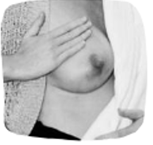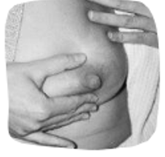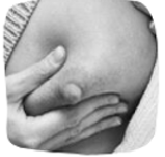Why Colostrum / Antenatal Expressing is Helpful
Exclusive breastfeeding is healthy for you and your baby. Colostrum is the first breast milk you will make and is very protective. It helps to regulate your baby’s blood sugar, protects from infection, increases bowel movements and is easy to digest.
Antenatal hand expressing’ is collecting your colostrum in the last few weeks prior to giving birth usually from 37 weeks of pregnancy.
Practising this skill may help you to get better at it and also give you reassurance that you are producing colostrum.
However, the amount obtained can vary from none at all, to a few drops, to a teaspoon full. Any amount collected will be valuable for your baby. The amount expressed during your pregnancy does not indicate how much milk you will produce after birth.
Your Midwife may have chosen to discuss antenatal hand expressing with you for varied reasons including:
• They may have noticed a reason why your baby might need some extra colostrum after birth to ensure your baby’s blood sugar is high enough.
• Your labour is being induced.
• A potential feeding challenge has been identified.
• Your baby may need to spend time on our Neonatal Unit.
• Personal choice to harvest your colostrum.
If you are unsure what that reason is, please ask your Midwife.
How to Store Your Colostrum
• Colostrum must be stored in purple feeding syringes with a sterile cap. These can be provided by your Midwife from 37 weeks.
• Syringes must be clearly labelled with your name, hospital number, date and time expressed.
• Colostrum is best stored in a freezer bag in the freezer straight after expressing.
Storage at home and in hospital differs slightly as the temperature and infection risk is higher in hospitals.
Maximum times for safe storage of breast milk in the home
Fresh breast milk:
Room temperature: 6 hours
Fridge: 5 to 10°C: 3 days
Fridge: 0 to 4°C: 8 days
Maximum times for safe storage of breast milk in the hospital
Fresh breast milk:
Room temperature: 4 hours
Fridge: 0 to 4°C: 48 hours
Freezer: -20°C or lower: 3 months
Bringing your colostrum into hospital
• Colostrum should be transported in a cool bag or box, with frozen ice packs.
• When you arrive to have your baby, please hand your labelled frozen colostrum to the Midwife and this will be kept in the freezer space on the antenatal or postnatal ward. This milk is your responsibility.
Defrosting colostrum
Breast milk is best thawed within the refrigerator and never refrozen once thawed. However, if needed quickly, it can be defrosted under cool, then warm, running water and the outside of the container dried before use or near to mothers’ skin.
Hand Expressing
Wash your hands well with soap and water.
Find a comfortable position and try to relax.
Make sure you have a clean sterile container or small syringe with a cap to collect your breast milk.
Before you start expressing carry out some gentle breast massage and nipple stimulation
Step 1 - Breast massage and nipple stimulation can be used to stimulate the milk ejection reflexes. Start by making gentle circles over the breast in the direction of the nipple. Follow this with some gentle strokes with your fingertips. This massage should only take a minute or two and can be repeated during your expressing session.

Step 2 - Cup your breast and feel back from the end of the nipple to where the texture of your breast feels different. Position your thumb and fingers in a ‘C’ shape, 2-3cm back from the base of your nipple. Press your thumb and fingers gently together and hold for a few seconds before releasing.

Step 3 - Continue this action in a slow rhythm. It may take a couple of minutes before your milk begins to drip. When the flow slows down, move your fingers around to try a different section of your breast and repeat. When that flow slows down, swap to the other breast. Keep changing breasts until the milk is dripping very slowly or stops altogether.

Step 4 - Collect any milk with a syringe or express into a sterile bottle or a colostrum pot. If the milk doesn’t flow, try moving your fingers slightly towards the nipple or further away and try more gentle breast massage.

Please note:
When you express you might feel your uterus going hard and relaxing. These are Braxton Hicks contractions. Don’t worry about these unless they begin to feel like period-type cramps or mild labour contractions. If this happens whilst you are at home, you should stop expressing and rest. If they don’t stop and you think you are in early labour, you should ring the Birth Suite for advice.
Hand expression video
Department: Maternity
Version Number: V1 2024-2027


